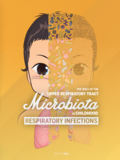The role of the upper respiratory tract microbiota in childhood respiratory infections

Man, Wing Ho
- Promoter:
- Prof.dr. E.A.M. (Lieke) Sanders & prof.dr. D. (Debby) Bogaert
- Co-promoter:
- Dr. M.A. (Marlies) van Houten
- Research group:
- Sanders
- Date:
- June 13, 2019
- Time:
- 12:45 h
Summary
Respiratory tract infections remain a leading cause of childhood morbidity and mortality worldwide. In this thesis, we have demonstrated that in childhood AOMT the nasopharyngeal microbiota considerably resembles and predicts the middle ear microbiota. We found evidence suggesting that the nasopharyngeal microbiota not only seeds the middle ear with bacteria including potential pathogens that might have initiated inflammation and infection, but also seem to determine recovery to health. Moreover, in children with LRTIs, the microbiota of the nasopharynx are strong biomarkers in case of lung disease. We identified specific viruses and bacterial taxa that were strongly associated with infection, and on the other hand consistently found a consortium of bacteria that were associated with health. Combining these viral and bacterial findings with data on the host, made it possible to classify health from disease with an unprecedented accuracy. Surprisingly, the microbial differences associated with childhood LRTI were disease phenotype-independent: we therefore postulate that treatment with targeted antibiotics should be based on predicted disease severity rather that clinical presentation per se. Furthermore, prophylaxis against the most common severe viral infection in infancy, RSV, was associated with persistent effects on the respiratory microbiota composition in early childhood that in turn was associated with reversible airway obstruction at age six suggesting the complexity of early life microbiota interventions. Finally, we show that early life loss of upper respiratory tract microbial topography, which among others seems determined by absence of certain keystone commensals, is associated with higher susceptibility to RTIs. This loss of topography was further driven by the influx of oral taxa in the nasopharynx. These data suggest that the infant respiratory microbiota play a pivotal role in maintaining the equilibrium that determines childhood respiratory health and disease. Humans are born in a microbial cloud and growing up as a child, simultaneously shaping your own personal microbiome, can be regarded an incredible ecological event. During our explorations, we discovered that the nasopharyngeal microbial community forms the boundary between the environment and the respiratory tract including ears and lungs, and that it has major promise for future diagnosis, treatment and prevention of childhood respiratory tract infections.